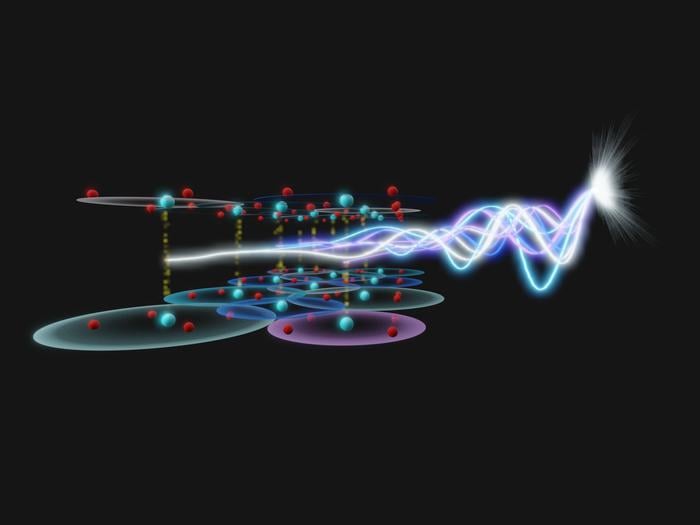Summary: Researchers use innovative terahertz spectroscopy to study disorder in high-temperature superconductors, offering new insights into these materials’ complex behavior.
Estimated reading time: 6 minutes
In an advance that could reshape our understanding of high-temperature superconductors, scientists have developed a novel technique to study disorder in these materials using terahertz light pulses.
This method, pioneered by researchers at the Max Planck Institute for the Structure and Dynamics of Matter (MPSD) in Germany and Brookhaven National Laboratory in the United States, allows for the examination of superconductor behavior at temperatures much closer to their transition point than ever before.
Shedding Light on Superconducting Disorder
Superconductivity, the phenomenon that allows electrical current to flow without resistance, has long captivated physicists and engineers alike. High-temperature superconductors, which operate at relatively warm temperatures (around -170°C), derive their remarkable properties from chemical doping. This process introduces disorder into the material’s structure, but its exact impact on superconductivity has remained elusive.
Traditional methods for studying disorder in superconductors, such as scanning tunneling microscopy, are limited to extremely low temperatures. This restriction has left a significant gap in our understanding of how these materials behave as they approach their critical transition temperature.
The team at MPSD has adapted a technique called multi-dimensional spectroscopy, originally developed for nuclear magnetic resonance, to work with terahertz frequencies. This innovative approach, dubbed angle-resolved two-dimensional terahertz spectroscopy (2DTS), allows researchers to probe the behavior of superconductors at much higher temperatures than previously possible.
Echoes of Superconductivity
The researchers applied their new technique to a cuprate superconductor called La1.83Sr0.17CuO4. They observed a phenomenon they termed “Josephson echoes” – a revival of superconducting transport after excitation by terahertz pulses.
These echoes revealed surprising information about disorder in the material. The disorder in superconducting transport was significantly lower than the disorder observed in the superconducting gap measured by spatial techniques like scanning microscopy.
Moreover, the team was able to measure disorder near the superconducting transition temperature for the first time. They found that it remained stable up to a relatively warm 70% of the transition temperature, a discovery that challenges existing theories about how these materials behave.
The implications of this research extend beyond cuprate superconductors. The ultrafast nature of 2DTS makes it applicable to transient states of matter too short-lived for conventional probes of disorder. This could lead to advances in understanding a wide range of quantum materials and their behavior under different conditions.
As we continue to unravel the mysteries of superconductivity, techniques like angle-resolved 2DTS promise to play a crucial role. They offer a new window into the intricate world of quantum materials, potentially paving the way for the development of room-temperature superconductors – a long-sought goal of materials science that could revolutionize energy transmission and storage.
Glossary of Superconductivity Terms
Superconductivity: A quantum phenomenon where electrical current flows without resistance in certain materials below a critical temperature.
High-temperature superconductors: Materials that become superconducting at relatively high temperatures (typically above -196°C, the boiling point of liquid nitrogen).
Chemical doping: The process of intentionally introducing impurities into a material to change its properties, often used in semiconductor and superconductor engineering.
Disorder: In materials science, refers to irregularities or imperfections in the atomic structure of a material.
Terahertz spectroscopy: A technique that uses terahertz radiation (between infrared and microwave frequencies) to study material properties.
Angle-resolved 2DTS: Angle-resolved two-dimensional terahertz spectroscopy, a new technique developed to study disorder in superconductors.
Josephson echoes: A phenomenon observed in the study where superconducting transport is revived after excitation by terahertz pulses.
Cuprate superconductor: A class of high-temperature superconductors containing copper-oxide layers.
Transition temperature: The temperature below which a material becomes superconducting.
Quantum materials: Materials whose properties are dominated by quantum mechanical effects.
Quiz: Test Your Superconductor Knowledge
- What is the primary advantage of the new terahertz spectroscopy technique described in the article? a) It allows for studying superconductors at room temperature b) It enables examination of superconductors closer to their transition temperature c) It completely eliminates disorder in superconductors d) It makes superconductors more efficient
- What phenomenon did the researchers observe and name in their experiments? a) Superconducting collapse b) Terahertz resonance c) Josephson echoes d) Quantum tunneling
- According to the article, how stable was the disorder in the studied superconductor? a) It was unstable at all temperatures b) It remained stable up to 50% of the transition temperature c) It remained stable up to 70% of the transition temperature d) It was only stable at extremely low temperatures
Answers:
- b) It enables examination of superconductors closer to their transition temperature
- c) Josephson echoes
- c) It remained stable up to 70% of the transition temperature
Further Reading
Enjoy this story? Get our newsletter! https://scienceblog.substack.com/


